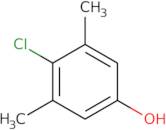Produktinformation
- 2,6-Dimethyl-4-hydroxy-1-chlorobenzene
- 2-Chloro-5-hydroxy-1,3-dimethylbenzene
- 2-Chloro-5-hydroxy-m-xylene
- 3,5-Dimethyl-4-chlorophenol
- 3,5-Dimethyl-p-chlorophenol
- 3,5-Xylenol, 4-Chloro-
- 4-Chlor-3,5-xylenol
- 4-Chloro-1-Hydroxy-3,5-Dimethylbenzene
- 4-Chloro-3,5-Dimethyl-Phenol
- 4-Chloro-3,5-m-Xylenol
- Mehr Synonyme anzeigen
- 4-Chloro-3,5-xylenol
- 4-Chloro-3,5-xylenol (OH=1)
- 4-Chloro-3-Xylenol
- 4-Chloro-5,3-dimethylphenol
- 4-Chloro-M-Xylenol
- 5-M-Xylenol (Chloroxylenol)
- Benzytol
- Camel
- Camel (pesticide)
- Chloroxylenol
- Cloroxilenol
- Desson
- Dettol
- Dettol (biocide)
- Ecotru
- Espadol
- Finecide C 2000
- Hokubarine E 400
- Husept Extra
- Nipacide PX
- Nipacide PX-R
- Nsc 4971
- Ottasept
- Ottasept Extra
- P-Chloro-M-Xylenol
- Para-Chloro-Meta-Xylene
- Parametaxylenol
- Pcmx
- Phenol, 4-chloro-3,5-dimethyl-
- Rba 777
- Xylenol, Meta, 4-Chloro-
- p-Chloro-3,5-xylenol
Chloroxylenol is a disinfectant and broad-spectrum antimicrobial agent used for the control of microbial growth in industrial and consumer products. The compound has been shown to have long-term toxicity in rats, with effects on the bowel and liver. Chloroxylenol is also an active ingredient in many household cleaning products, including soaps, detergents, and disinfectants. It is used as an antimicrobial agent for wastewater treatment, as well as a preservative for wood. Other uses include its use as an analytical reagent in the detection of halogenated aromatic compounds such as triclosan.
Chloroxylenol has been shown to be more effective than benzalkonium chloride or copper chloride against various bacteria strains. Potassium dichromate has also been shown to be effective against certain bacteria, but it is not considered a safe chemical to handle due to its corrosive nature and carcinogenic effects.





